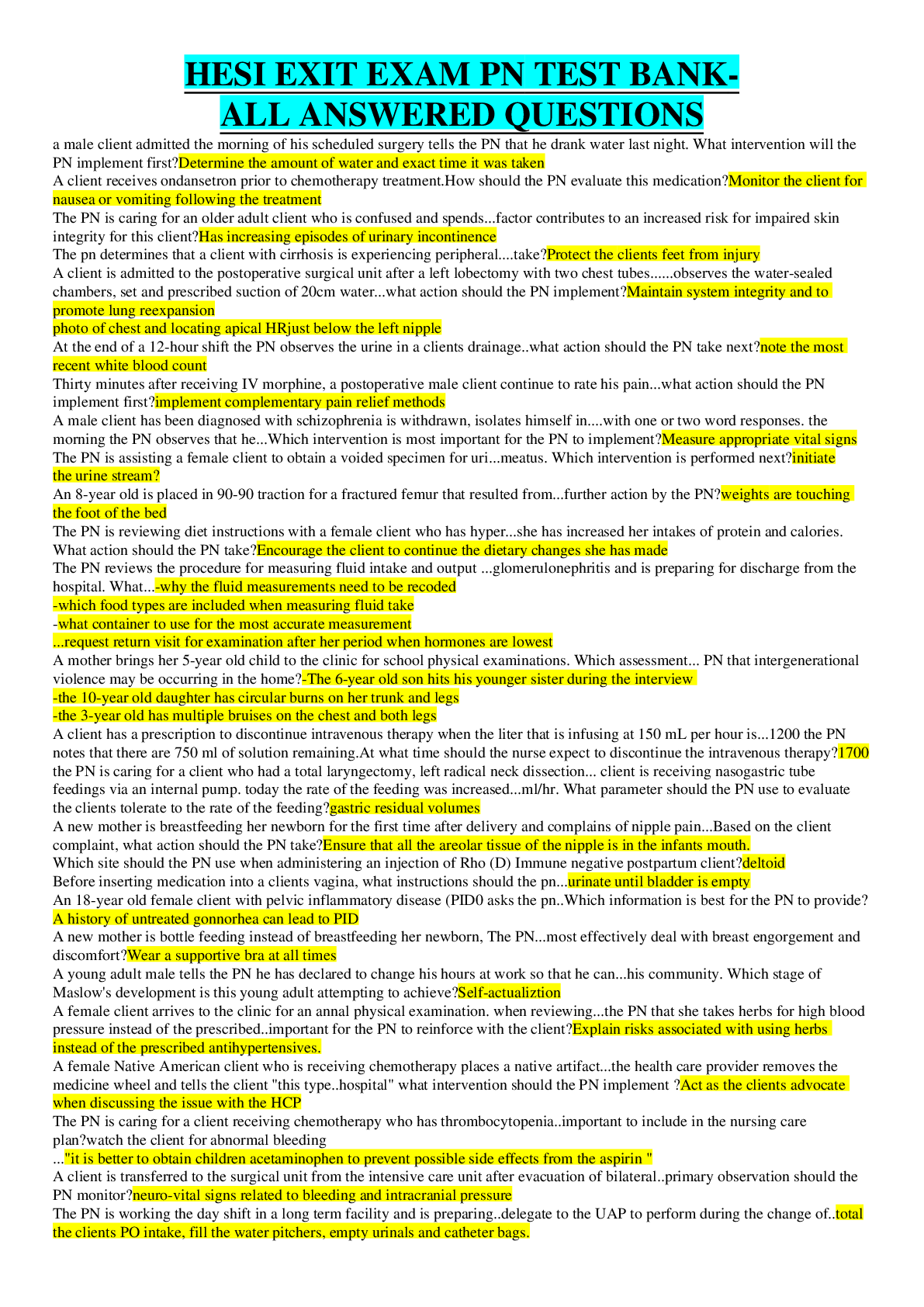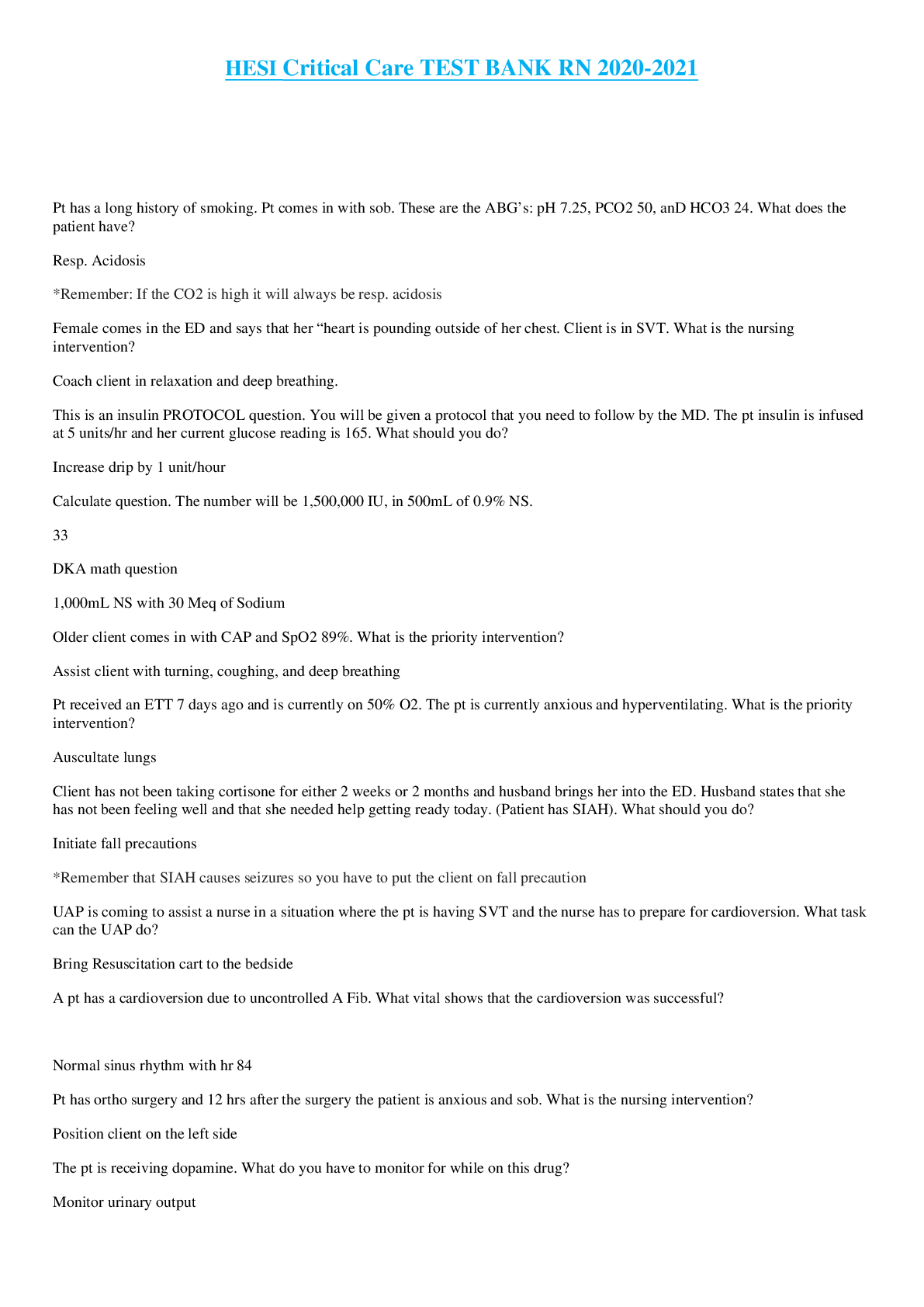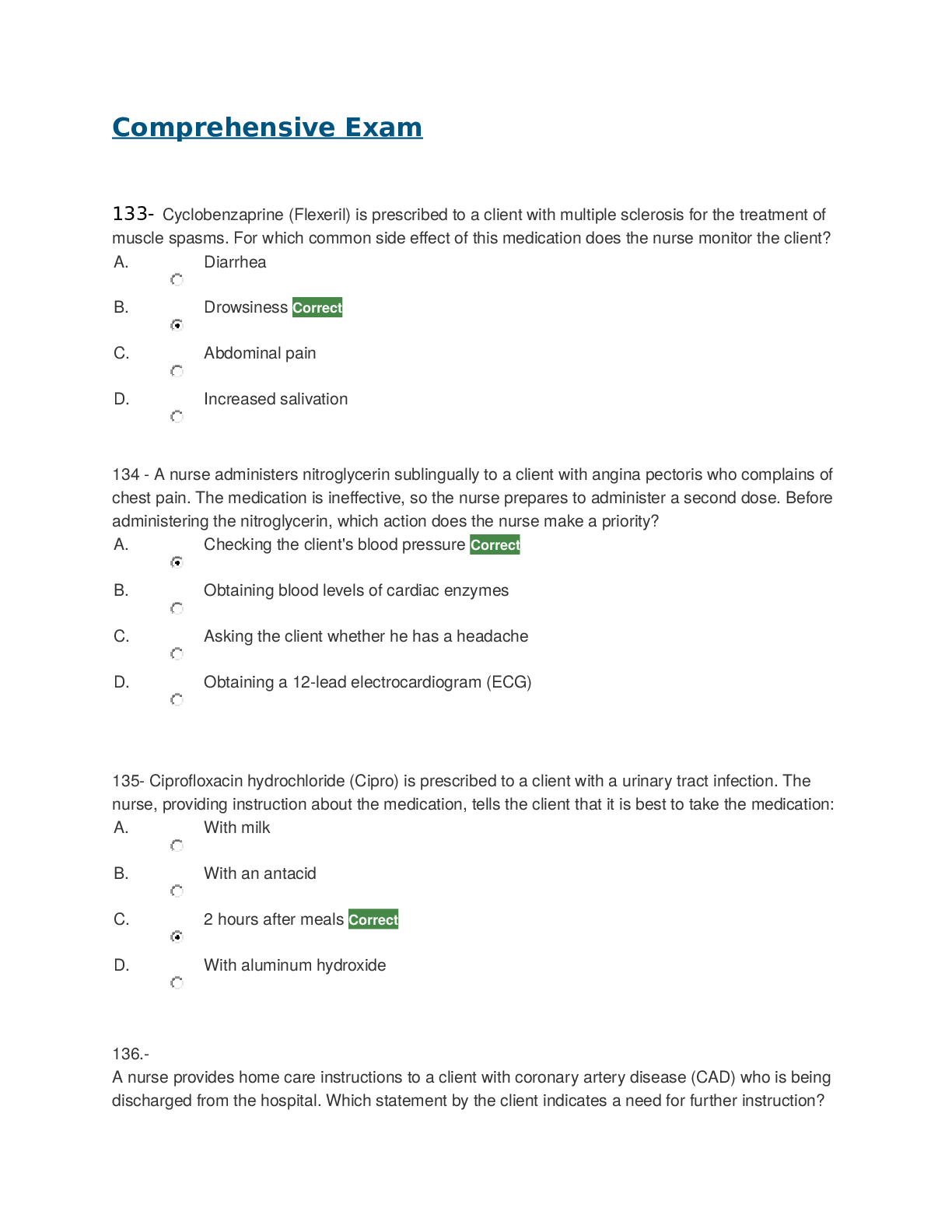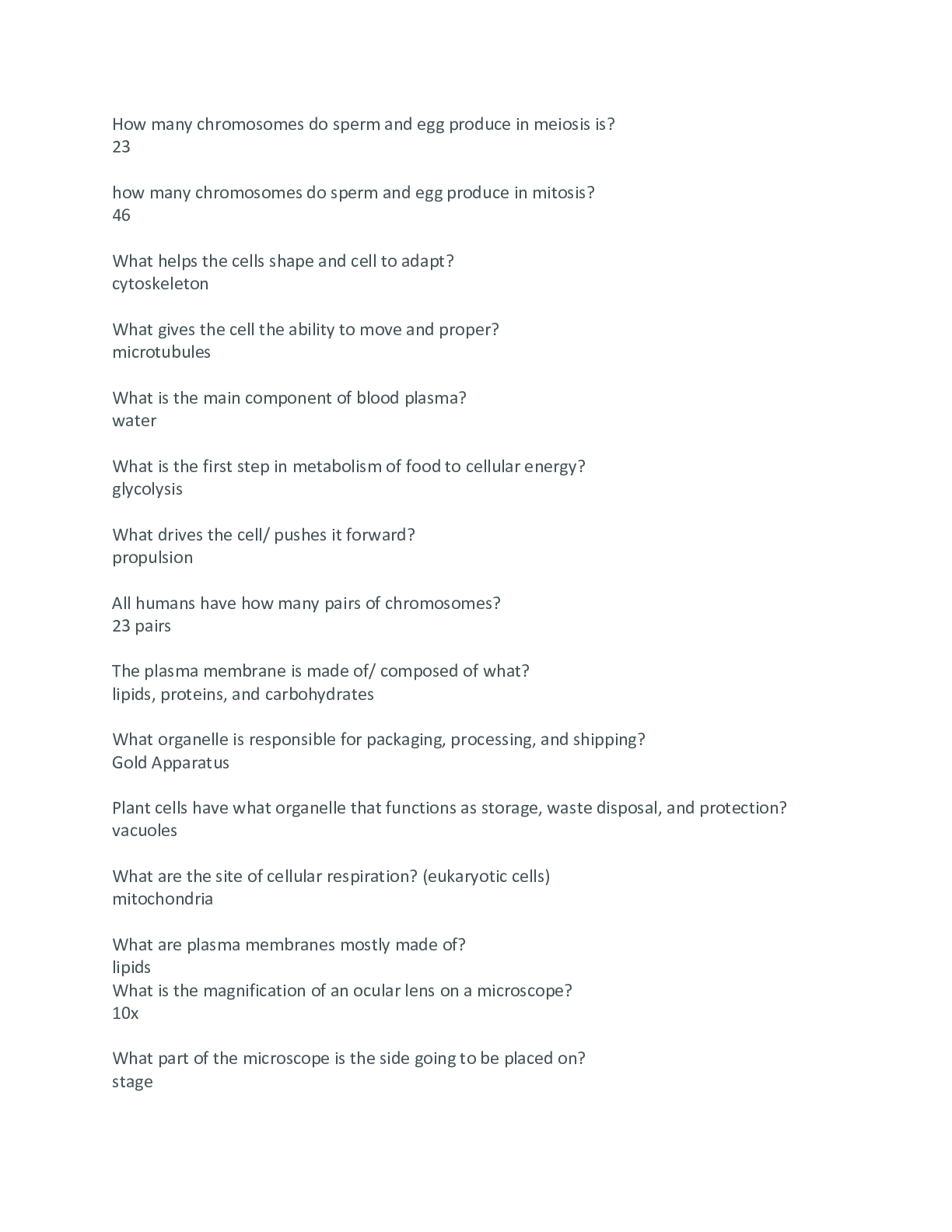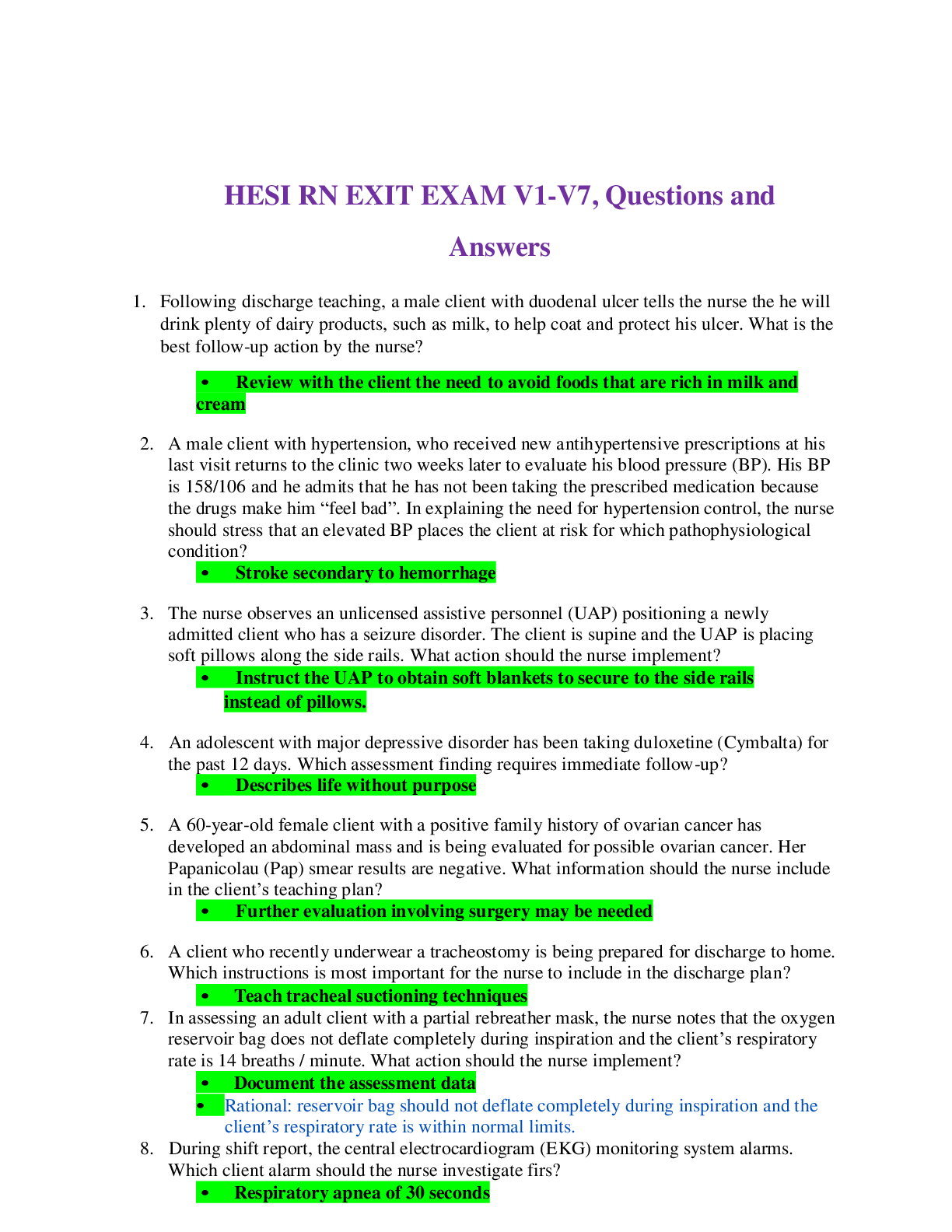*NURSING > HESI > Pharmacology Hesi Exam Latest 2021 with complete solutions, Graded A+, 2022/2023. (All)
Pharmacology Hesi Exam Latest 2021 with complete solutions, Graded A+, 2022/2023.
Document Content and Description Below
Pharmacology Hesi Exam Latest 2021 with complete solutions Which nursing action is the priority when administering chelation therapy for a toddler-age client? 1 Assessing vital signs 2 Monitoring ... urine output 3 Conducting a behavioral assessment 4 Providing education to reduce lead exposure Correct Answer- 2 A 67-year-old client has tested positive for influenza A. The client also has asthma. Which drug would the nurse recommend be avoided in this client? 1 Ribavirin 2 Zanamivir 3 Oseltamivir 4 Amantadine Correct Answer- 2 Which first line medication would the nurse state is used to treat anaphylactic reactions? 1 Epinephrine 2 Norepinephrine 3 Dexamethasone 4 Diphenhydramine Correct Answer- 1 A mother complains that her child's teeth have become yellow in color. With prolonged use, which medication may be responsible for the child's condition? 1 Tetracycline 2 Promethazine 3 Chloramphenicol 4 Fluoroquinolones Correct Answer- 1 What are the desired outcomes that the nurse expects when administering a nonsteroidal antiinflammatory drug (NSAID)? Select all that apply 1 Diuresis 2 Pain relief 3 Antipyresis4 Bronchodilation 5 Anticoagulation 6 Reduced inflammation Correct Answer- 2,3,6 A client with tuberculosis is started on a chemotherapy protocol that includes rifampin. The nurse evaluates that the teaching about rifampin is effective when the client makes which statement? 1 "I need to drink a lot of fluid while I take this medication." 2 "I can expect my urine to turn orange from this medication." 3 "I should have my hearing tested while I take this medication." 4 "I might get a skin rash because it is an expected side effect of this medication. Correct Answer- 2 Which statement regarding treatment with interferon indicates that the client understands the nurse's teaching? 1 "I will drink 2 to 3 quarts (2 to 3 liters) of fluid a day." 2 "Any reconstituted solution must be discarded in 1 week." 3 "I can continue driving my car as long as I have the stamina." 4 "While taking this medicine I should be able to continue my usual activity." Correct Answer- 1 A nurse administers the drug desmopressin acetate (DDAVP) to a client with diabetes insipidus. What should the nurse monitor to evaluate the effectiveness of the drug? 1 Arterial blood pH 2 Intake and output 3 Fasting serum glucose 4 Pulse and respiratory rates Correct Answer- 2 A client will be taking nitrofurantoin 50 mg orally every evening at home to manage recurrent urinary tract infections. What instructions should the nurse give to the client? 1 Increase the intake of fluids. 2 Strain the urine for crystals and stones. 3 Stop the drug if urinary output increases. 4 Maintain the exact time schedule for taking the drug Correct Answer- 1 A client admitted to the hospital with a diagnosis of chronic obstructive pulmonary disease has received a prescription for a medication that is delivered via a nebulizer. When teaching about use of the nebulizer, the nurse should teach the client to do what? 1 Hold the breath while spraying the medication into the mouth.2 Position the lips loosely around the mouthpiece and take rapid, shallow breaths. 3 Seal the lips around the mouthpiece and breathe in and out, taking slow, deep breaths. 4 Inhale the medication from the nebulizer, remove the mouthpiece from the mouth, and then exhale. Correct Answer- 3 A client is diagnosed with pulmonary tuberculosis, and the healthcare provider prescribes a combination of rifampin and isoniazid. The nurse evaluates that the teaching regarding the drug is effective when the client reports which action as most important? 1 "Report any changes in vision." 2 "Take the medicine with my meals." 3 "Call my doctor if my urine or tears turn red-orange." 4 "Continue taking the medicine even after I feel better. Correct Answer- 4 A nurse administers beclomethasone by inhalation to a client with asthma, and the client asks why this medication is necessary. What should the nurse explain is the purpose of this pharmacologic therapy? 1 Promotes comfort 2 Decreases inflammation 3 Stimulates smooth muscle relaxation 4 Reduces bacteria in the respiratory tract Correct Answer- 2 A nurse is caring for a female client who is receiving rifampin for tuberculosis. Which statements indicate that the client understands the teaching about rifampin? Select all that apply 1 "This drug may be hard on my liver so I must avoid alcoholic drinks while taking it." 2 "This drug may reduce the effectiveness of the oral contraceptive I am taking." 3 "I cannot take an antacid within 2 hours before taking my medicine." 4 "My healthcare provider must be called immediately if my eyes and skin become yellow. Correct Answer- 1,2,4 The nurse provides discharge teaching to a client with tuberculosis. Which treatment measure does the nurse reinforce as the highest priority? 1 Getting sufficient rest 2 Getting plenty of fresh air 3 Changing the current lifestyle 4 Consistently taking prescribed medication Correct Answer- 4A client is diagnosed with tuberculosis associated with human immunodeficiency virus infection. What crucial laboratory test results should the nurse review before antitubercular pharmacotherapy is started? 1 Liver function studies 2 Pulmonary function studies 3 Electrocardiogram and echocardiogram 4 White blood cell (WBC) count and sedimentation rate Correct Answer- 1 Pyridoxine (vitamin B6) and isoniazid (INH) are prescribed as part of the chemotherapy protocol for a client with tuberculosis. Which response indicates to the nurse that vitamin B6 is effective? 1 Weight gain 2 Absence of stomatitis 3 Absence of numbness and tingling in extremities 4 Acceleration of dormant tubercular bacilli destruction Correct Answer- 3 A healthcare provider prescribes a medication to be administered via a metered-dose inhaler (MDI) for a young adult with asthma. List in order the steps the nurse teaches the client to follow when using the inhaler. 1. Shake the inhaler for 30 seconds. 2. Hold the inhaler upright in the mouth. 3. Exhale slowly and deeply to empty the air from the lungs. 4. Start breathing in and press down on the inhaler once Correct Answer- 1,3,2,4 A client with tuberculosis is to begin combination therapy with isoniazid, rifampin, pyrazinamide, and streptomycin. The client says, "I've never had to take so much medication for an infection before." How will the nurse respond? 1 "This type of organism is difficult to destroy." 2 "Streptomycin prevents side effects of the other drugs." 3 "You'll only need to take the medications for a couple of weeks." 4 "Aggressive therapy is needed because the infection is well advanced." Correct Answer- 1 A client is admitted to the hospital with a diagnosis of an exacerbation of asthma. What should the nurse plan to do to best help this client? 1 Determine the client's emotional state. 2 Give prescribed drugs to promote bronchiolar dilation. 3 Provide education about the impact of a family history.4 Encourage the client to use an incentive spirometer routinely Correct Answer- 2 The nurse is preparing to administer an intravenous piggyback antibiotic that has been newly prescribed. Shortly after initiation, the client becomes restless and flushed and begins to wheeze. The nurse determines the that appropriate priority action will be to stop the antibiotic infusion and then do what? 1 Notify the physician immediately about the client's condition. 2 Take the client's blood pressure. 3 Obtain the client's pulse oximetry. 4 Assess the client's respiratory status Correct Answer- 4 A client has an anaphylactic reaction after receiving intravenous penicillin. What does the nurse conclude is the cause of this reaction? 1 An acquired atopic sensitization occurred. 2 There was passive immunity to the penicillin allergen. 3 Antibodies to penicillin developed after a previous exposure. 4 Potent antibodies were produced when the infusion was instituted Correct Answer- 3 During the administration of total parenteral nutrition (TPN), an assessment of the client reveals a bounding pulse, distended jugular veins, dyspnea, and cough. What is the priority nursing intervention? 1 Restart the client's infusion at another site. 2 Slow the rate of the client's infusion of the TPN. 3 Interrupt the client's infusion and notify the healthcare provider. 4 Obtain the vital signs and continue monitoring the client's status Correct Answer- 3 A client develops a fever after surgery. Ceftriaxone is prescribed. For which potential adverse effect should the nurse monitor the client? 1 Dehydration 2 Heart failure 3 Constipation 4 Allergic response Correct Answer- 4 A healthcare provider prescribes famotidine and magnesium hydroxide/aluminum hydroxide antacid for a client with a peptic ulcer. The nurse should teach the client to take the antacid at what time? 1 Only at bedtime, when famotidine is not taken 2 Only if famotidine is ineffective3 At the same time as famotidine, with a full glass of water 4 One hour before or 2 hours after famotidine Correct Answer- 4 A healthcare provider prescribes an antibiotic intravenous piggyback twice a day for a client with an infection. The healthcare provider prescribes peak and trough levels 48 and 72 hours after initiation of the therapy. The client asks the nurse why there is a need for so many blood tests. What reason does the nurse provide? 1 "They determine adequate dosage levels of the drug." 2 "They detect if you are having an allergic reaction to the drug." 3 "The tests permit blood culture specimens to be obtained when the drug is at its lowest level." 4 "These allow comparison of your fever to when the blood level of the antibiotic is at its highest." Correct Answer- 1 A nurse is administering a histamine H2 antagonist to a client who has extensive burns. The nurse explains to the client that this drug is given prophylactically during the first few weeks after extensive burns. What complication of burns will it prevent? 1 Colitis 2 Gastritis 3 Stress ulcer 4 Metabolic acidosis Correct Answer- 3 A client is receiving penicillin G and probenecid for syphilis. What rationale should the nurse give for the need to take these two drugs? 1 Each drug attacks the organism during different stages of cell multiplication. 2 The penicillin treats the syphilis, whereas the probenecid relieves the severe urethritis. 3 Probenecid delays excretion of penicillin, thus maintaining blood levels for longer periods. 4 Probenecid decreases the potential for an allergic reaction to penicillin, which treats the syphilis Correct Answer- 3 Ampicillin 250 mg by mouth every 6 hours is prescribed for a client who is to be discharged. Which statement indicates to the nurse that the client understands the teaching about ampicillin? 1 "I should drink a glass of milk with each pill." 2 "I should drink at least six glasses of water every day." 3 "The medicine should be taken with meals and at bedtime." 4 "The medicine should be taken one hour before or two hours after meals Correct Answer- 4A healthcare provider prescribes ampicillin for a client with an infection. What information should the nurse include in the teaching plan about this medication? 1 Take the ampicillin with meals. 2 Store the ampicillin in a light-resistant container. 3 Notify the healthcare provider if diarrhea develops. 4 Continue the drug until a negative culture is obtained Correct Answer- 3 A nurse is caring for a client who has been taking several antibiotic medications for a prolonged time. Because long-term use of antibiotics interferes with the absorption of fat, what prescription does the nurse anticipate? 1 High-fat diet 2 Supplemental cod liver oil 3 Total parenteral nutrition (TPN) 4 Water-soluble forms of vitamins A and E Correct Answer- 4 A health care provider prescribes vancomycin peak and trough levels for a client who is receiving vancomycin intravenous piggyback (IVPB). When should the nurse have the laboratory obtain a blood sample to determine a peak level of the antibiotic? 1 Halfway between two doses of the drug 2 Between 30 and 60 minutes after a dose 3 Immediately before the medication is administered 4 Anytime it is convenient for the client and the laboratory Correct Answer- 2 A client is started on tetracycline antibiotic therapy. What should the nurse do when administering this drug? 1 Administer the medication with meals or a snack. 2 Provide orange or other citrus fruit juice with the medication. 3 Give the medication an hour before milk products are ingested. 4 Offer antacids 30 minutes after administration if gastrointestinal side effects occur Correct Answer- 3 A client with gastroesophageal reflux disease (GERD) receiv [Show More]
Last updated: 1 year ago
Preview 1 out of 19 pages
Instant download

Instant download
Reviews( 0 )
Document information
Connected school, study & course
About the document
Uploaded On
Sep 14, 2022
Number of pages
19
Written in
Additional information
This document has been written for:
Uploaded
Sep 14, 2022
Downloads
0
Views
123
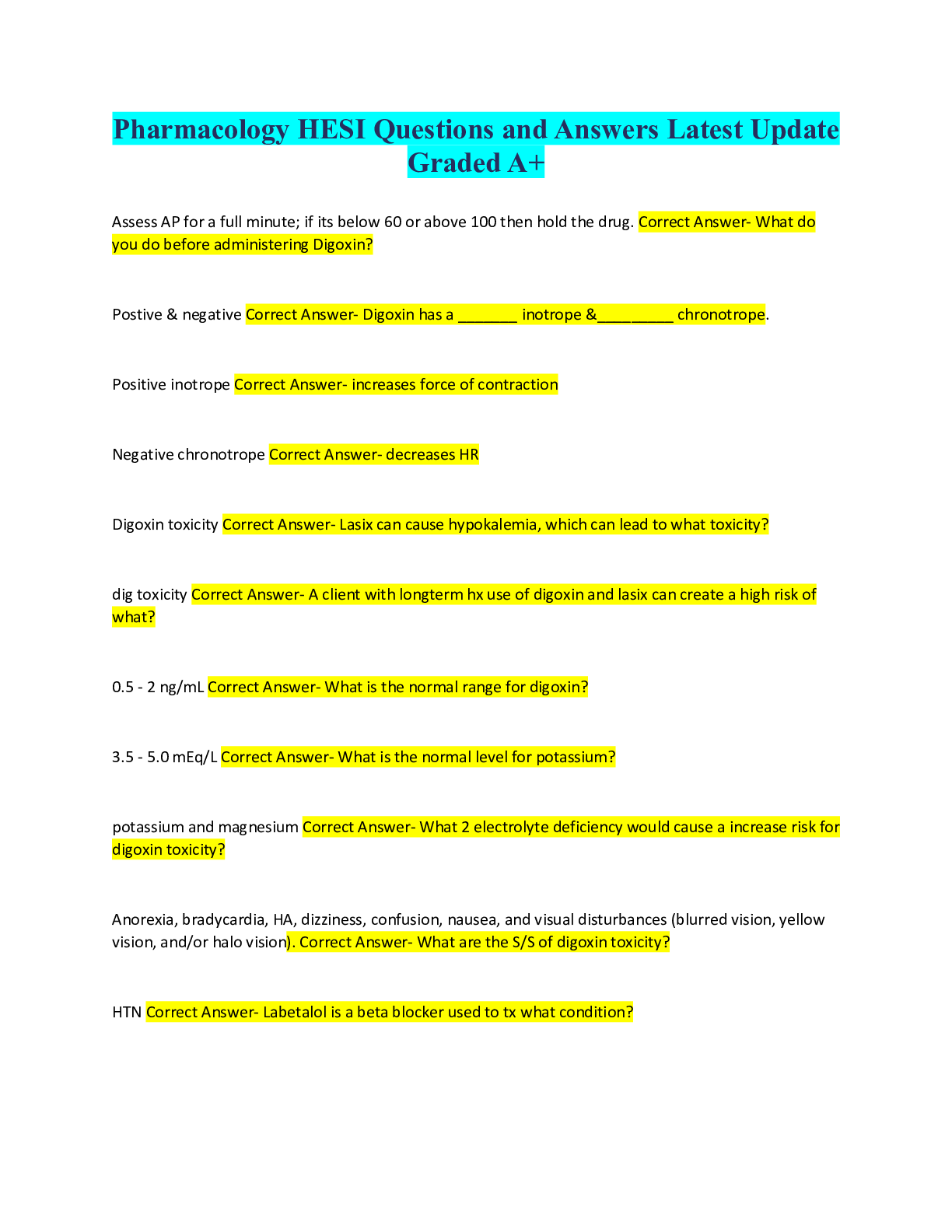

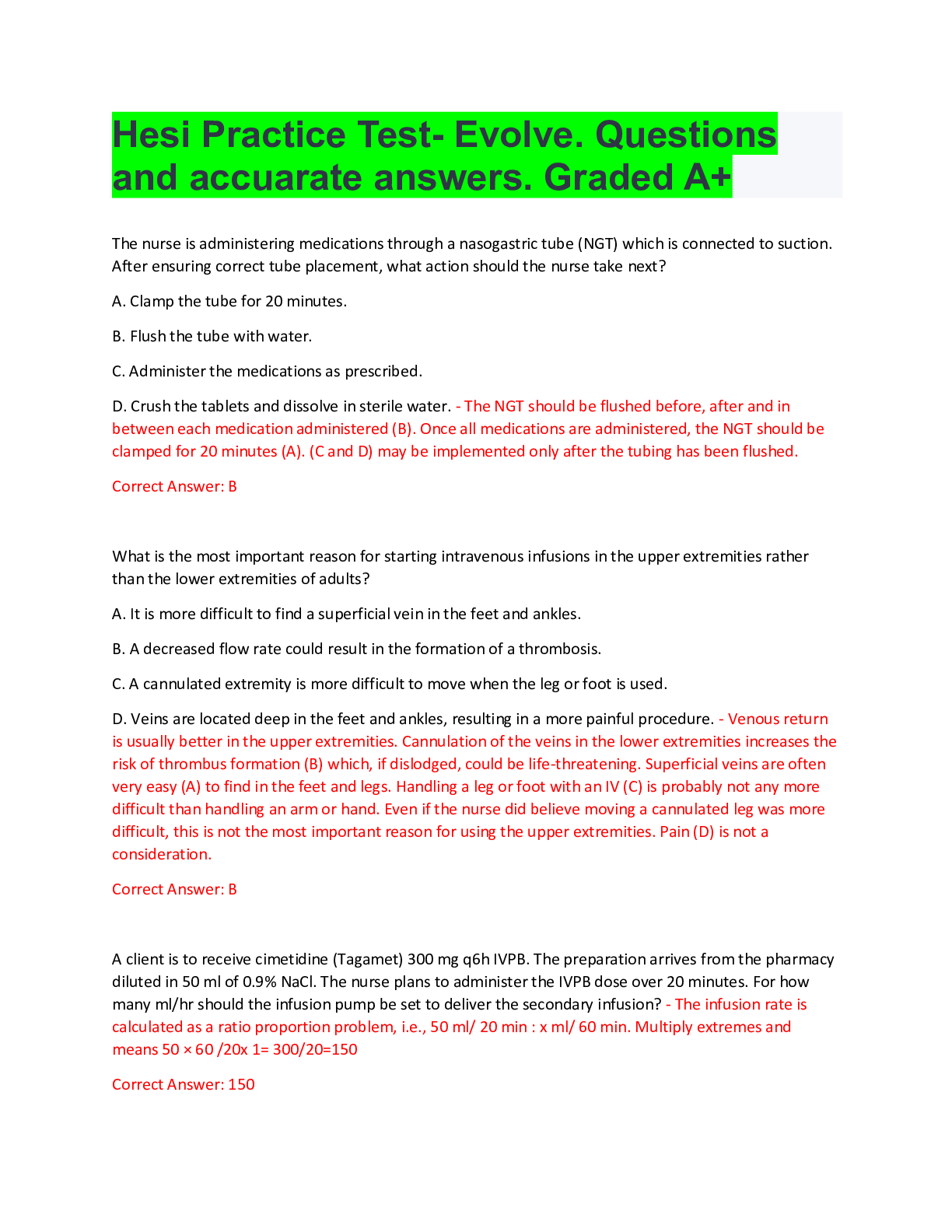
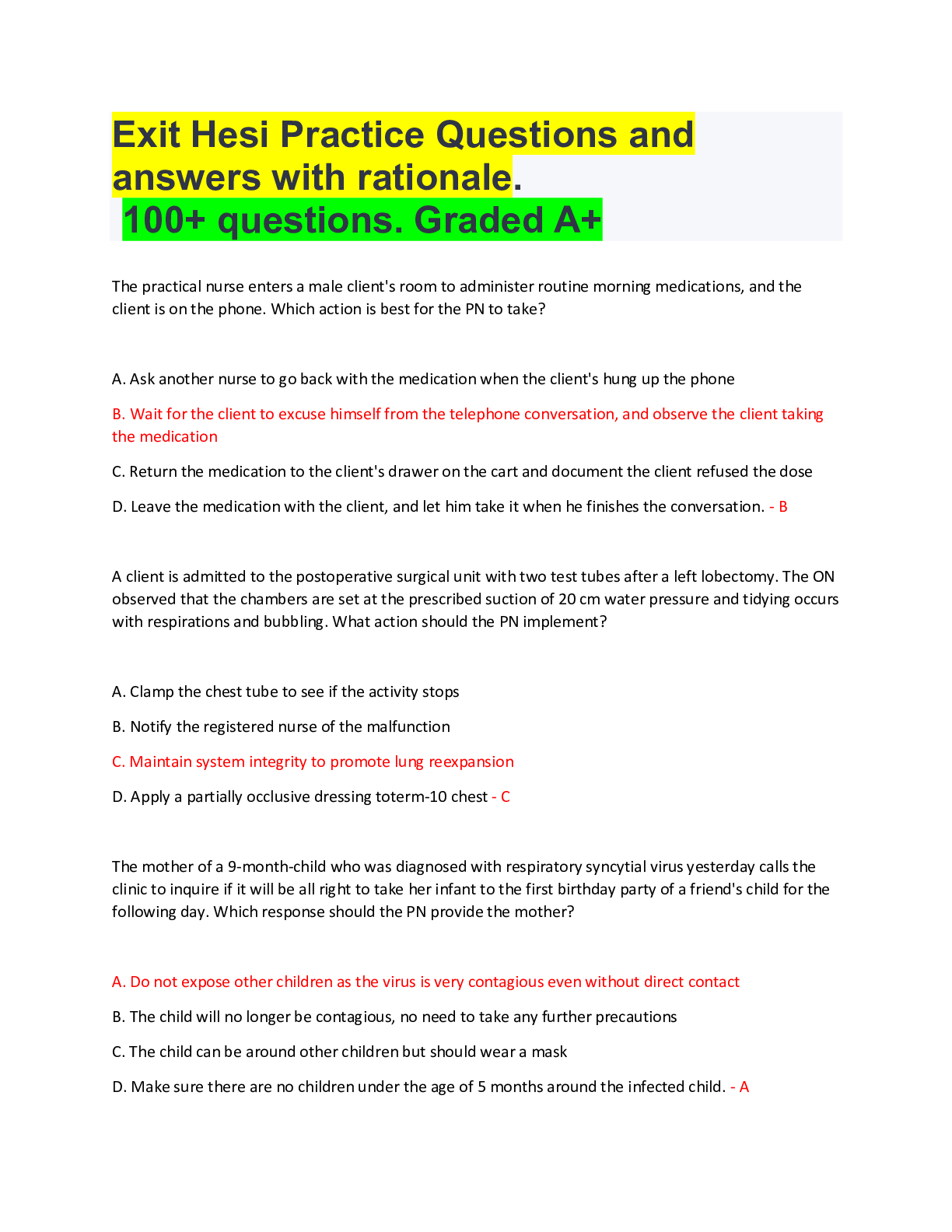
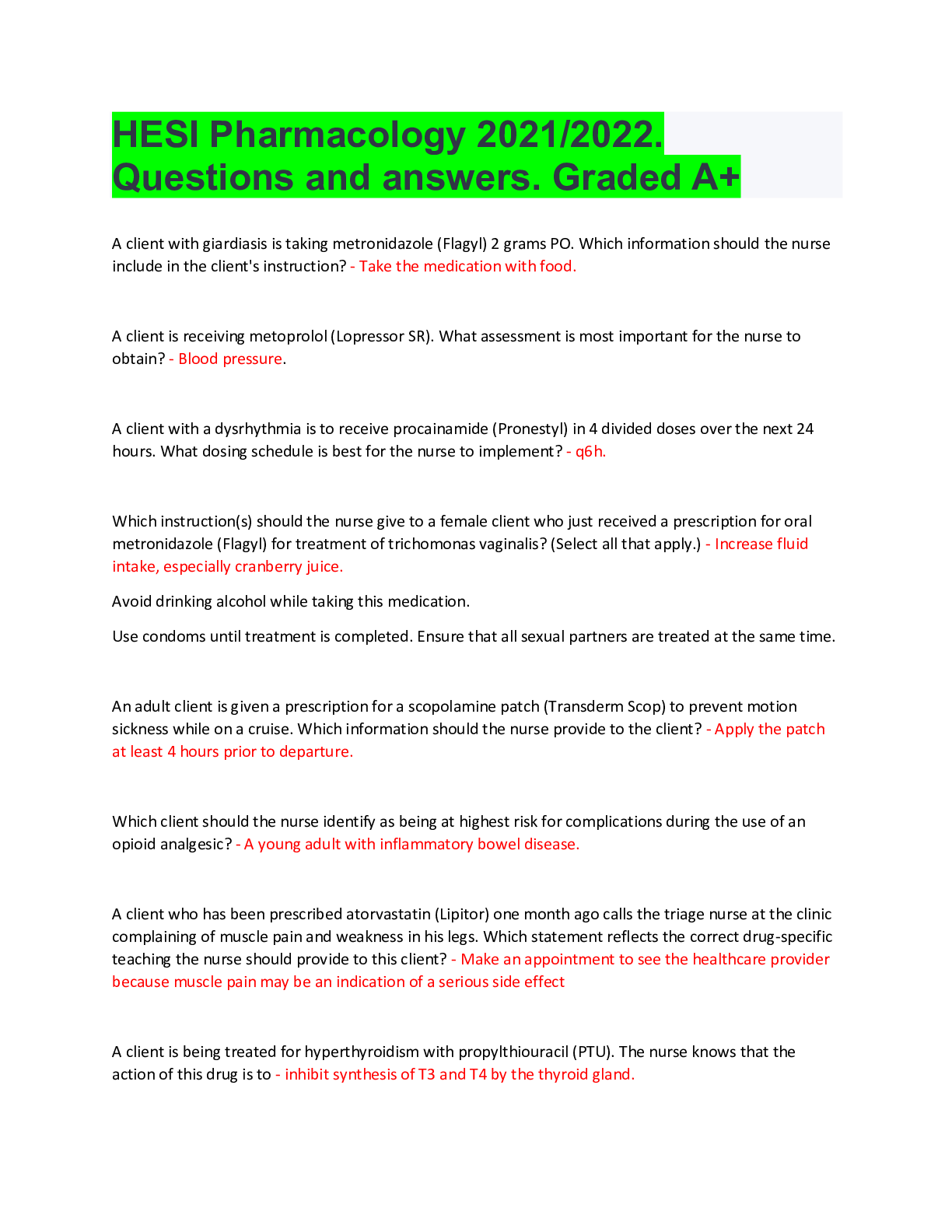
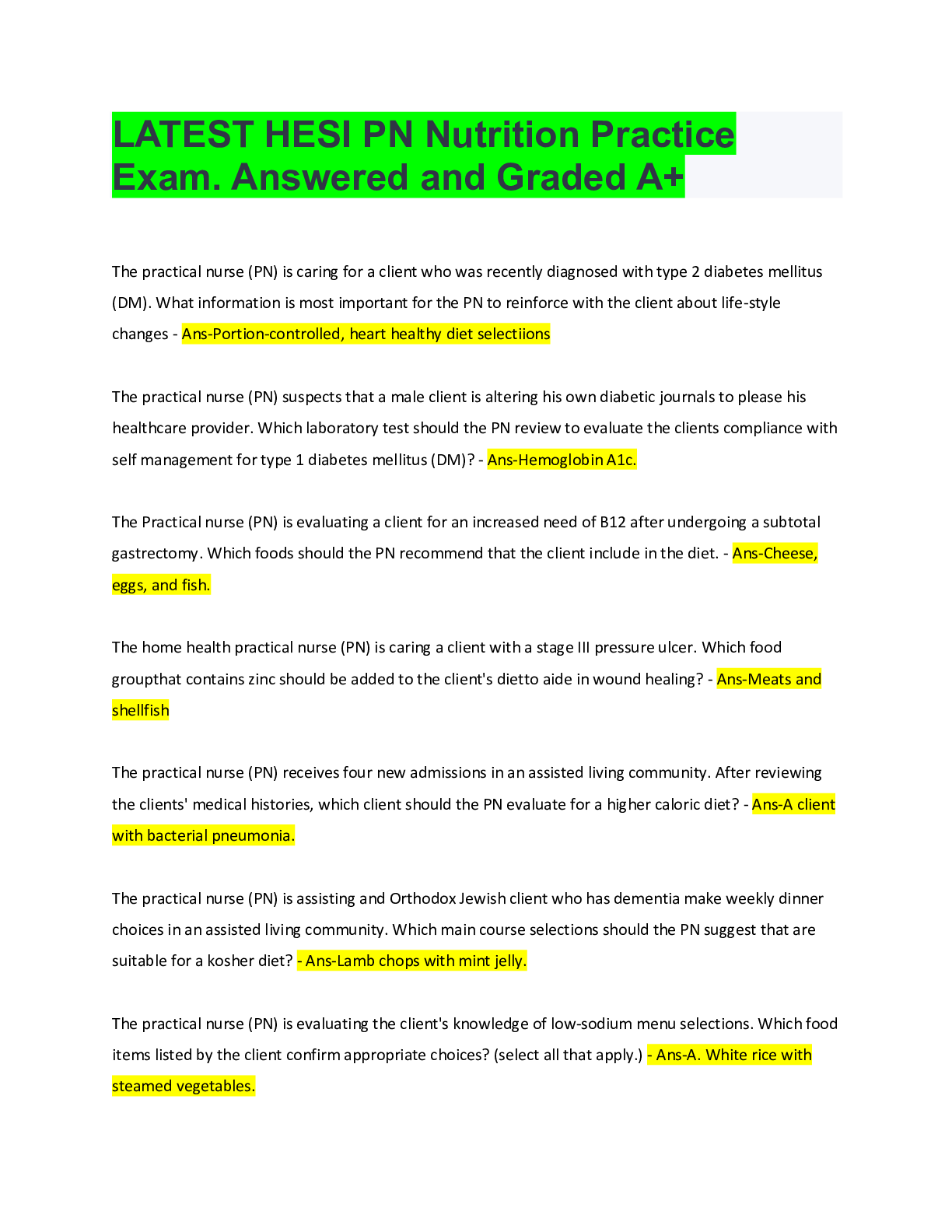

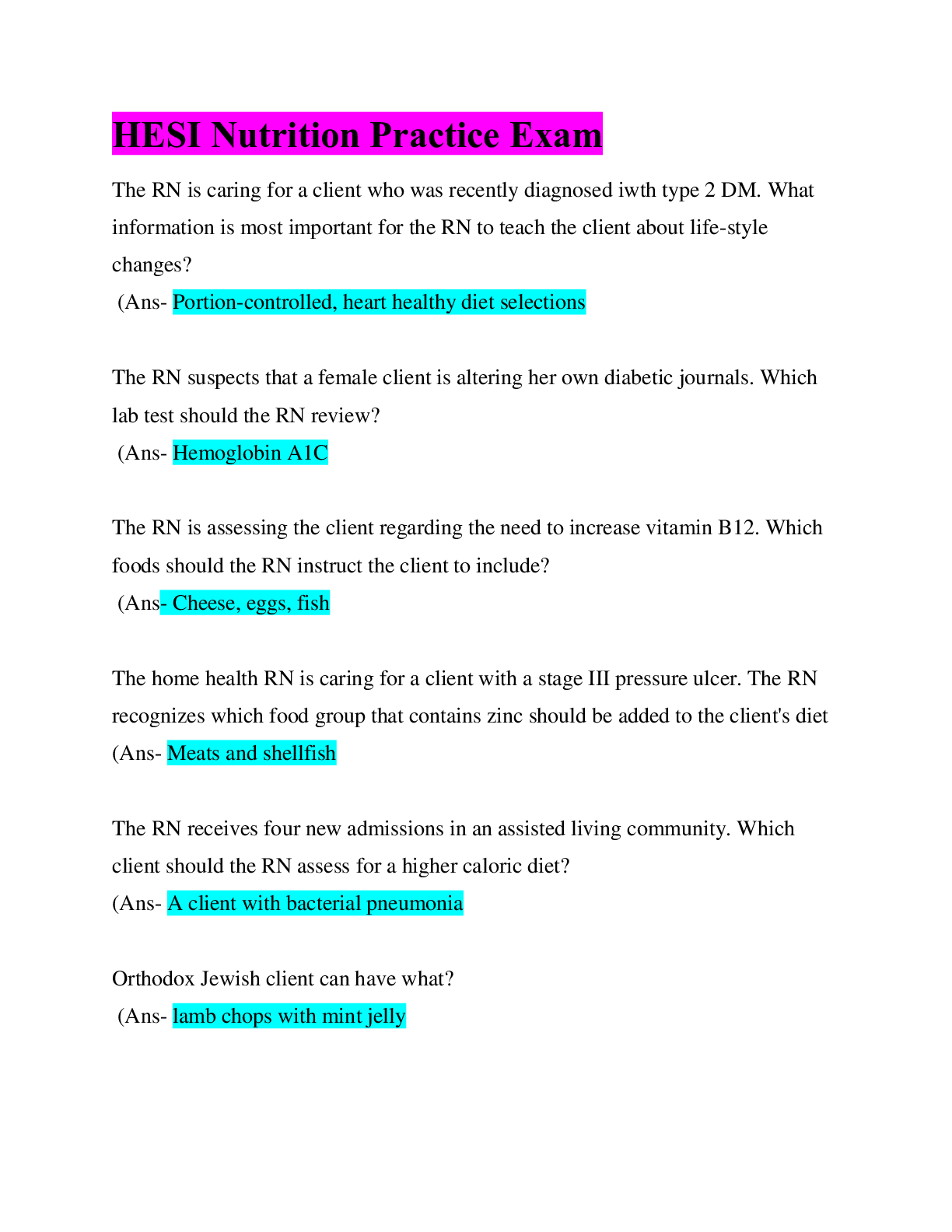
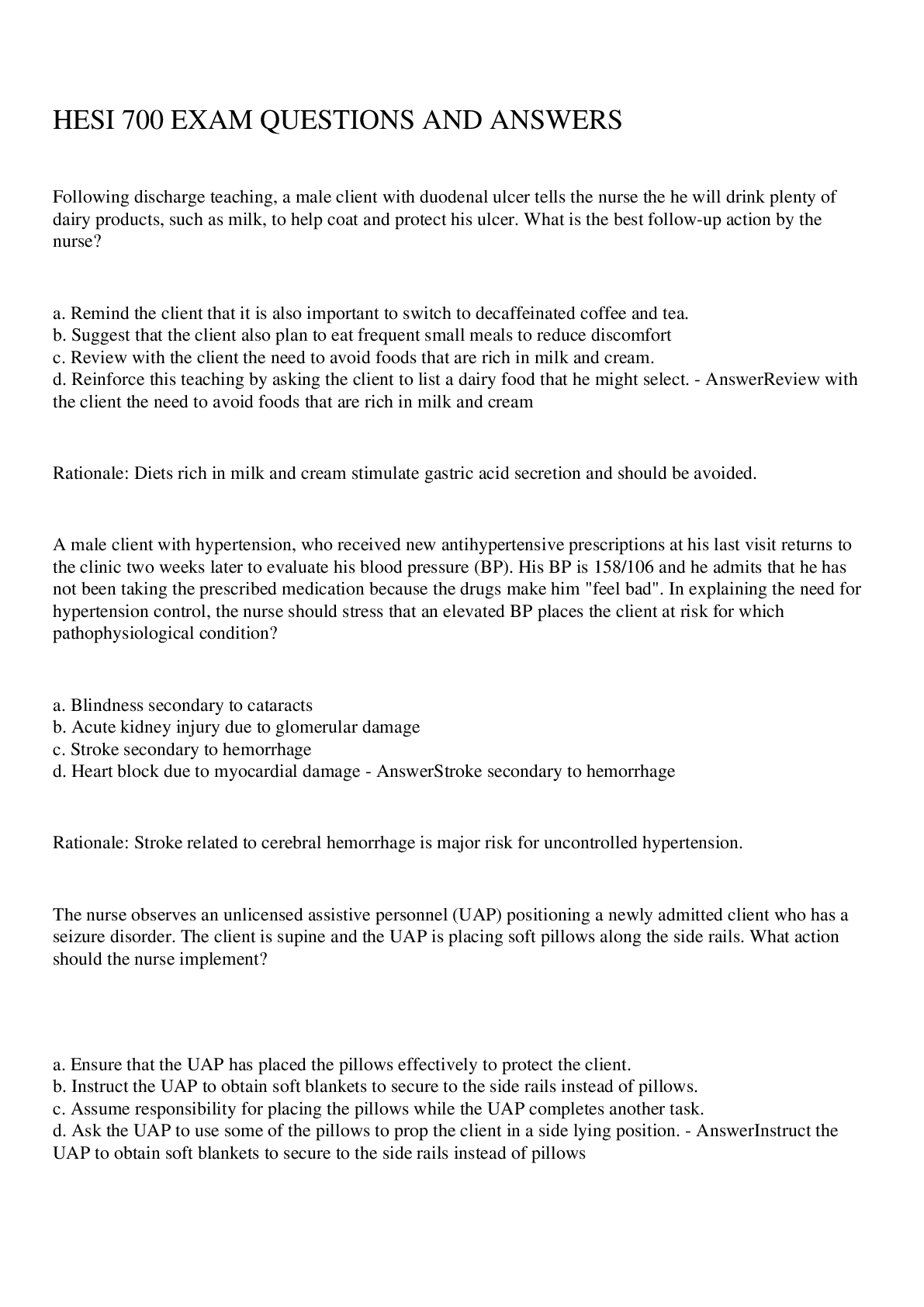

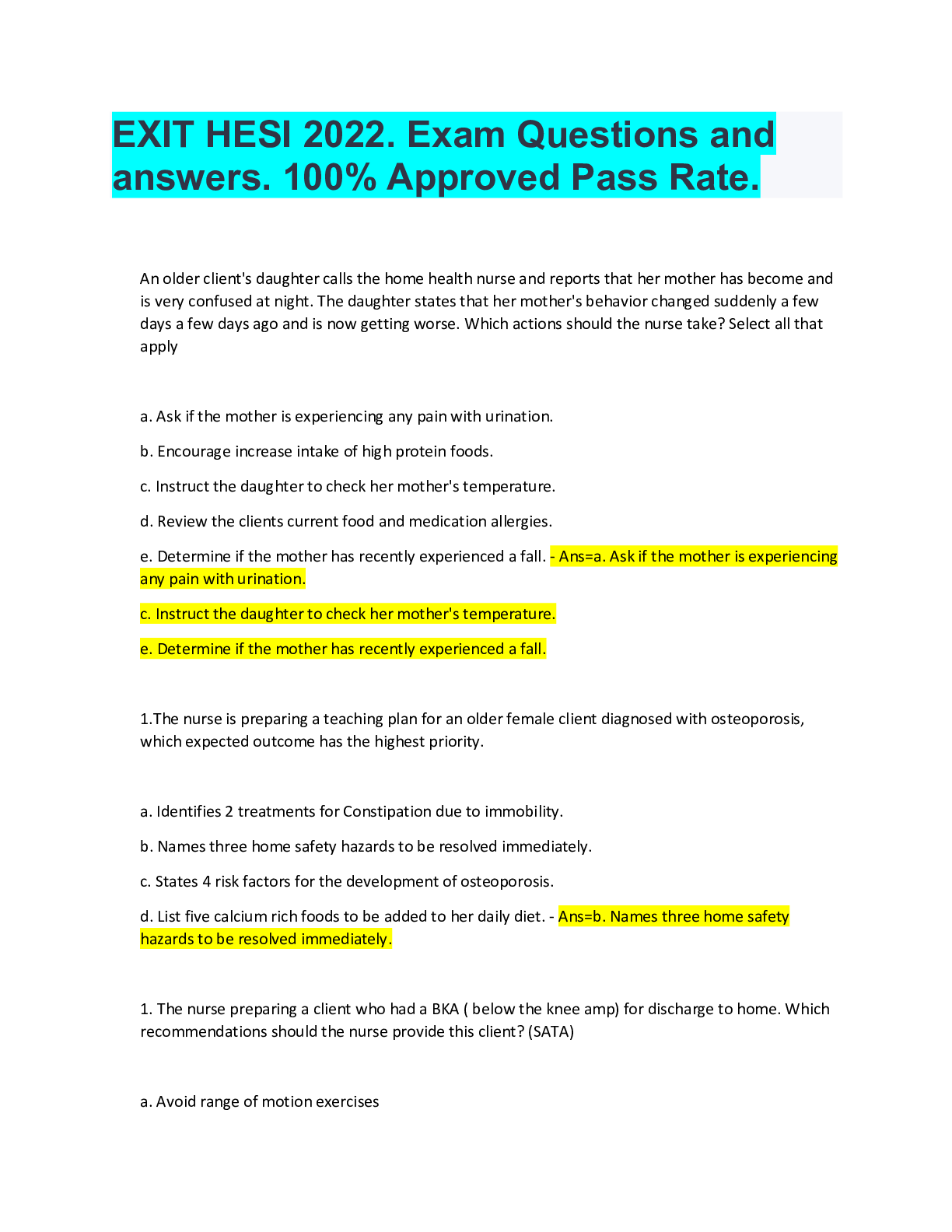
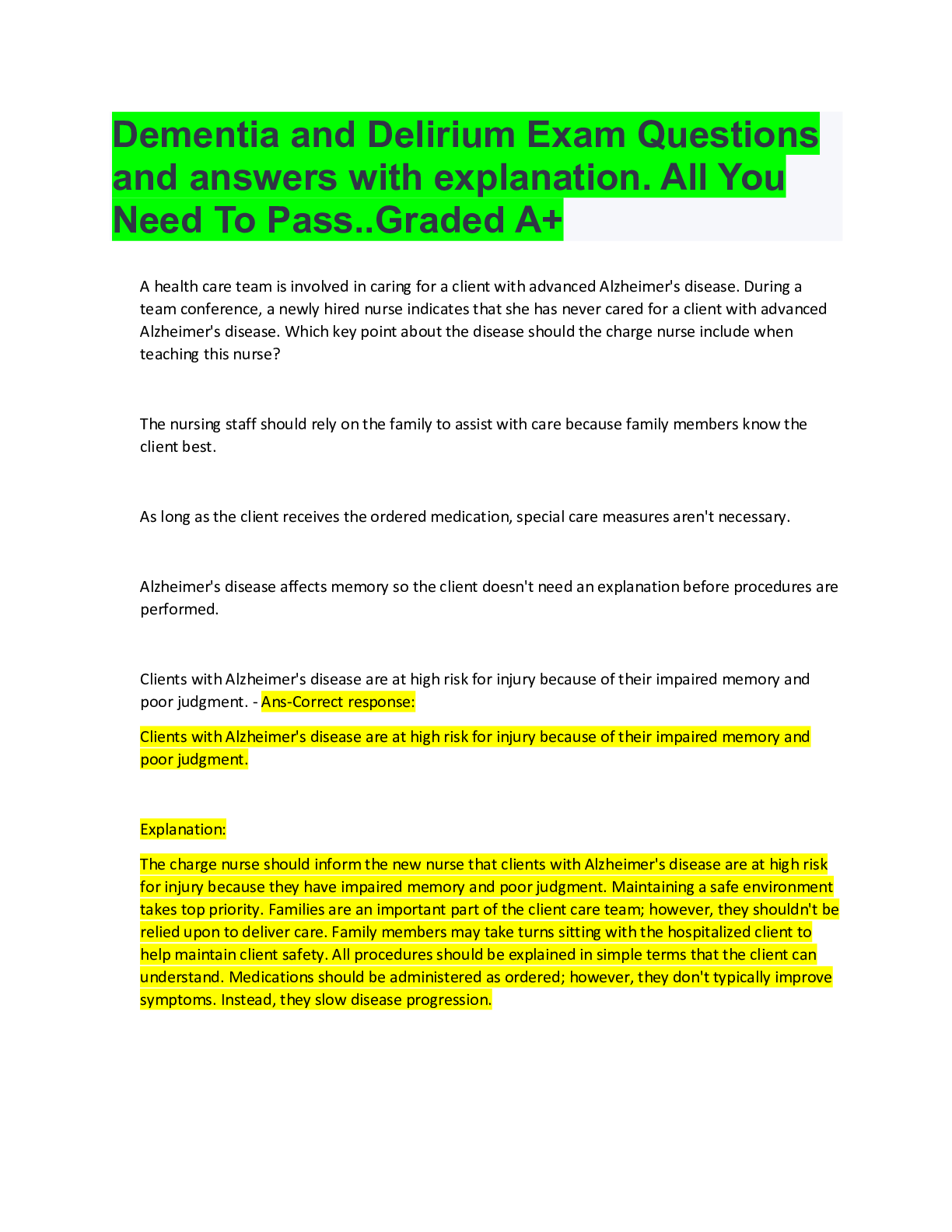


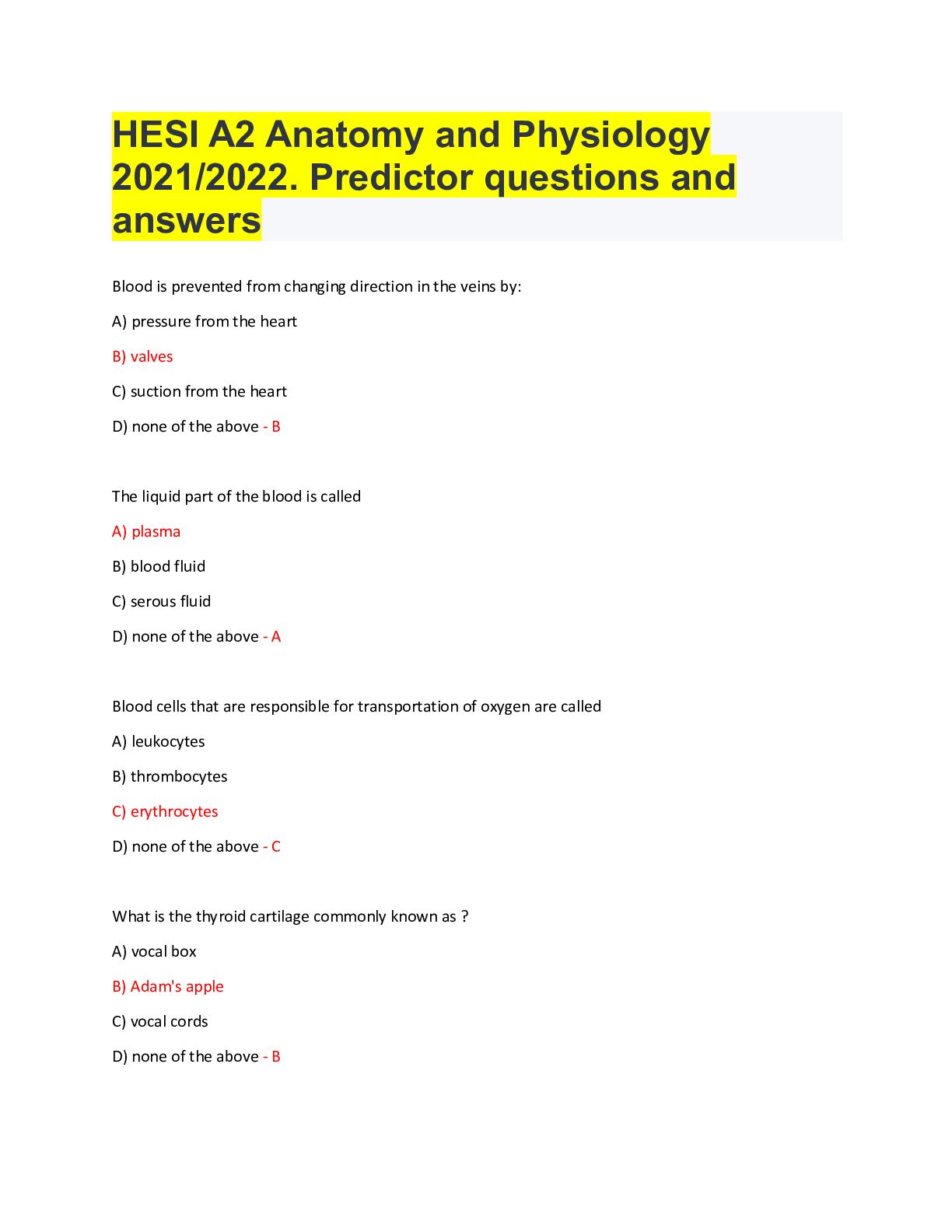

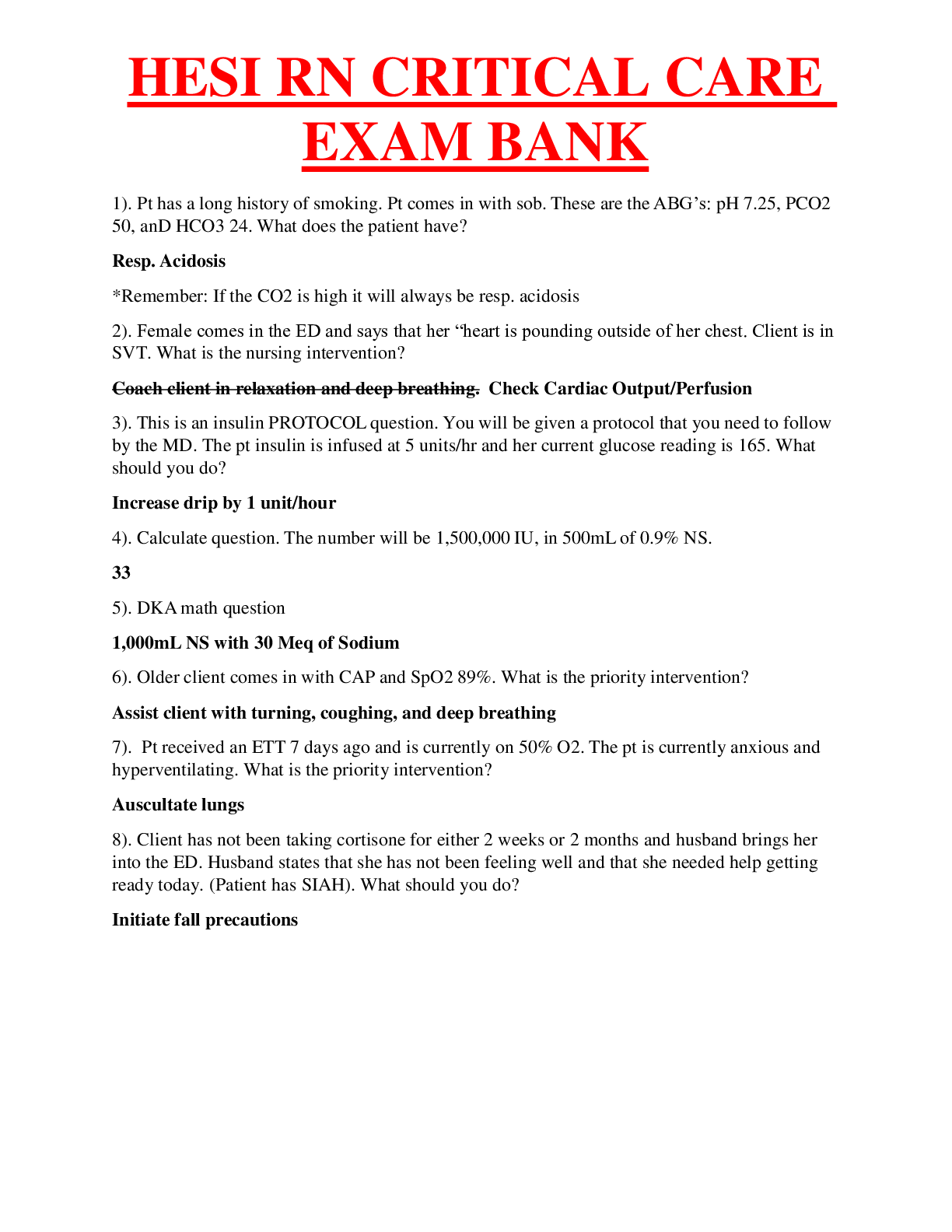
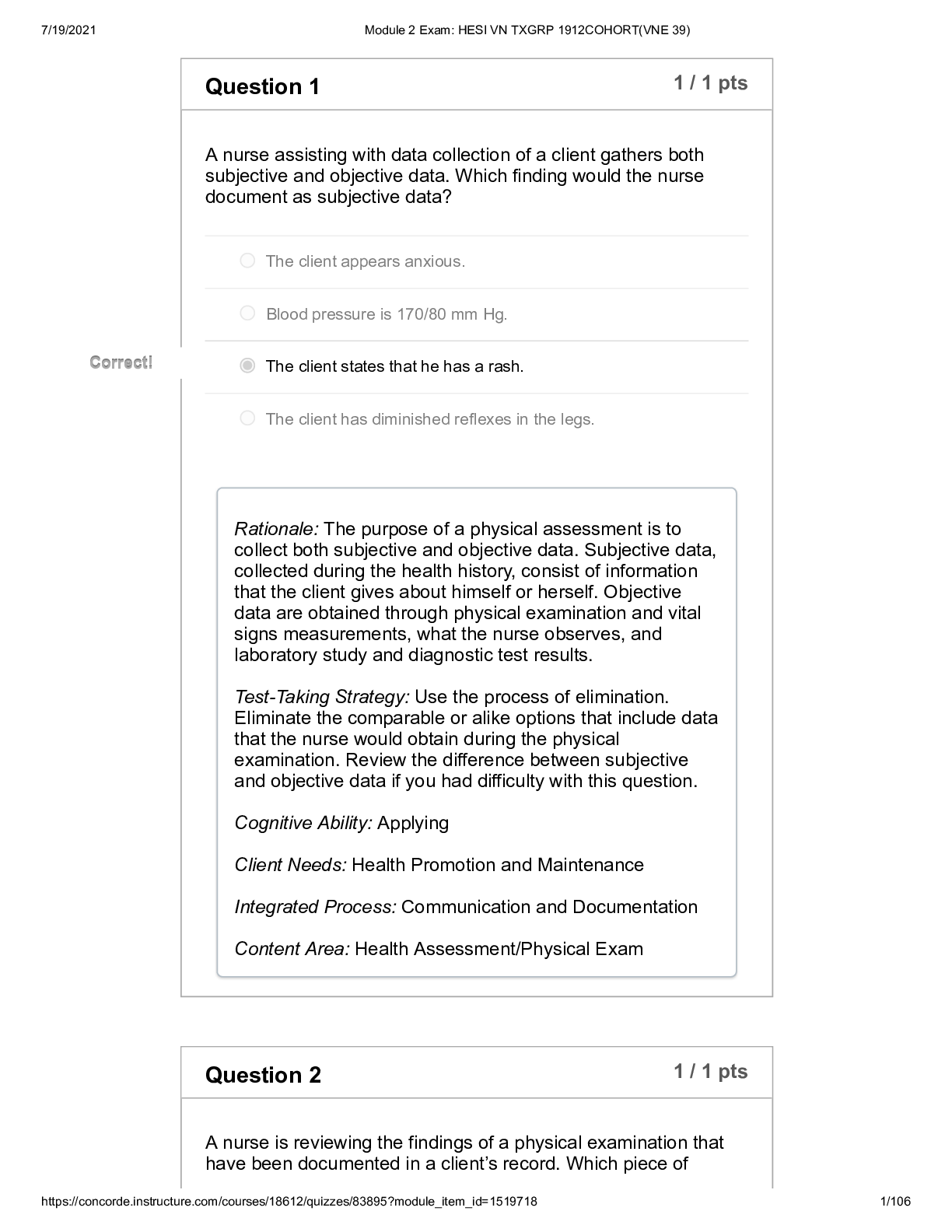
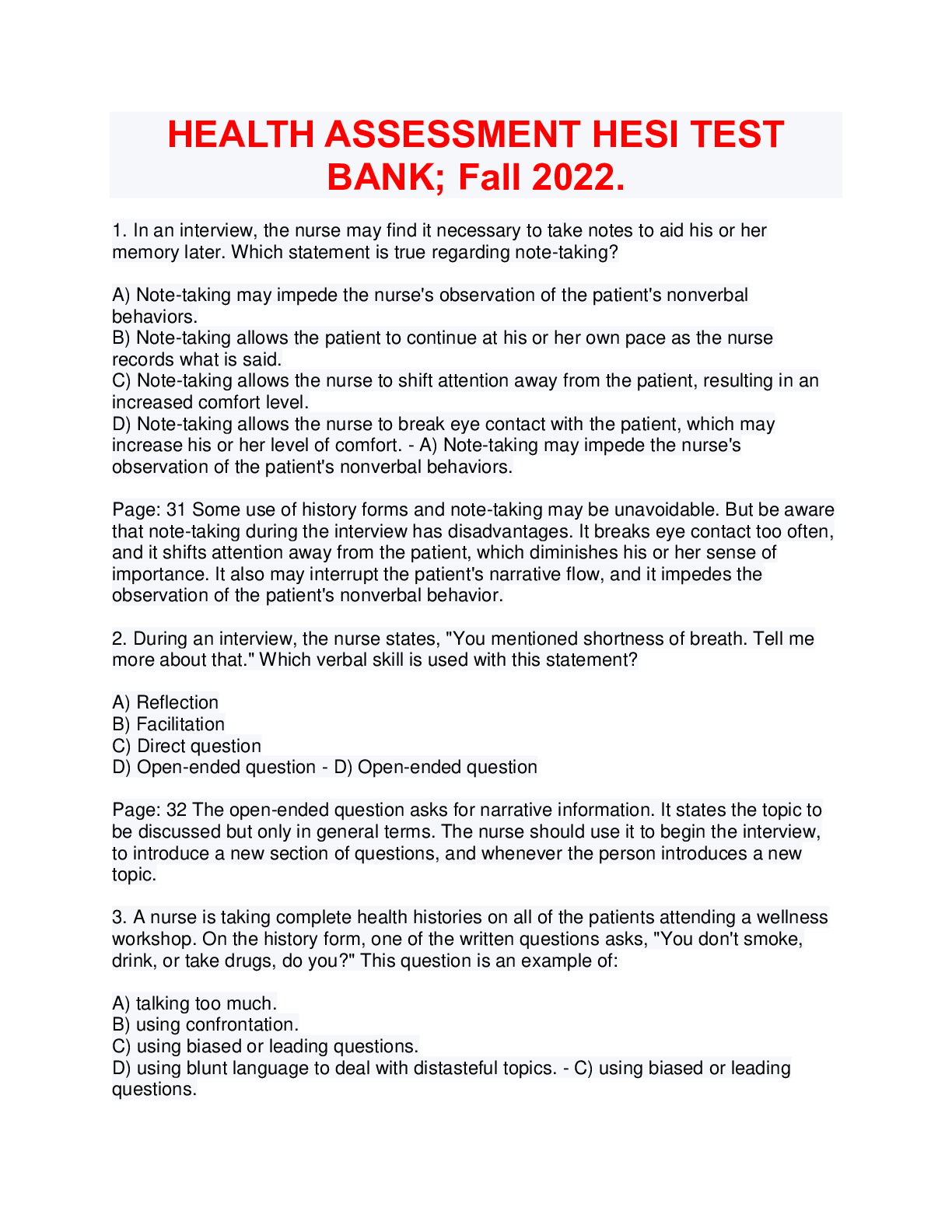
 Practice Test 2022.png)

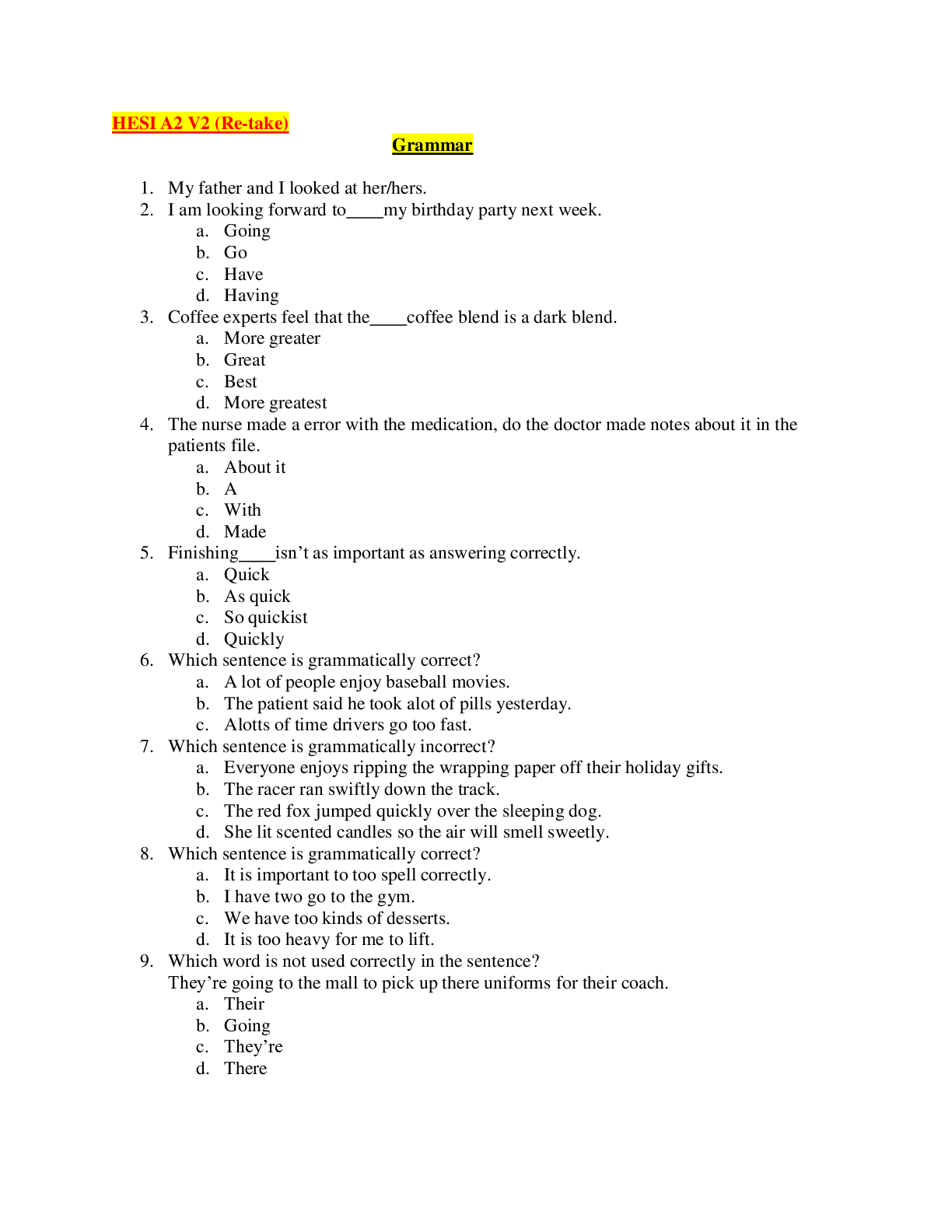





 (1).png)



